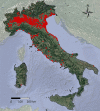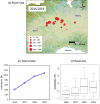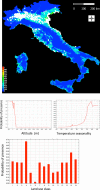The spreading of the invasive sacred ibis in Italy
- PMID: 33420080
- PMCID: PMC7794294
- DOI: 10.1038/s41598-020-79137-w
The spreading of the invasive sacred ibis in Italy
Abstract
The spreading of invasive species in new continents can vary from slow and limited diffusion to fast colonisations over vast new areas. We studied the sacred ibis Threskiornis aethiopicus along a 31-year period, from 1989 to 2019, with particular attention to the first area of release in NW Italy. We collected data on species distribution through observations by citizen science projects, population density by transects with distance method, breeding censuses at colonies, and post breeding censuses at roosts. The birds counted at winter roosts in NW Italy increased from a few tens up to 10,880 individuals in 2019. Sacred ibises started breeding in 1989, with a single nest in north-western Italy. The number of breeders remained very low until 2006, when both overwintering and breeding sacred ibises started to increase exponentially and expand their range throughout northern Italy with isolated breeding cases in central Italy. In 2019, the number of nests had increased to 1249 nests in 31 colonies. In NW Italy, the density of foraging birds averaged 3.9 ind./km2 in winter and 1.5 ind./km2 in the breeding period, with a mean size of the foraging groups of 8.9 and 2.1 birds respectively. Direct field observations and species distribution models (SDM) showed that foraging habitats were mainly rice fields and wetlands. A SDM applied to the whole Italian peninsula plus Sardinia and Sicily showed that the variables best related to the SDM were land class (rice fields and wetlands), altitude, and the temperature seasonality. The areas favourable for species expansion encompass all the plains of Northern Italy, and several areas of Tuscany, Latium, Sardinia, and Apulia.
Conflict of interest statement
The authors declare no competing interests.
Figures





References
-
- Wittenberg R, Cock MJW. Invasive Alien Species: A Toolkit of Best Prevention and Management Practices. Wallingford: CABI; 2001.
-
- Genovesi P. Eradications of invasive alien species in Europe: a review. Biol. Invas. 2005;7:127–133. doi: 10.1007/s10530-004-9642-9. - DOI
-
- Vilà M, et al. How well do we understand the impacts of alien species on ecosystem services? A pan-European, cross-taxa assessment. Front. Ecol. Environ. 2010;8:135–144. doi: 10.1890/080083. - DOI
Publication types
MeSH terms
LinkOut - more resources
Full Text Sources
Other Literature Sources

